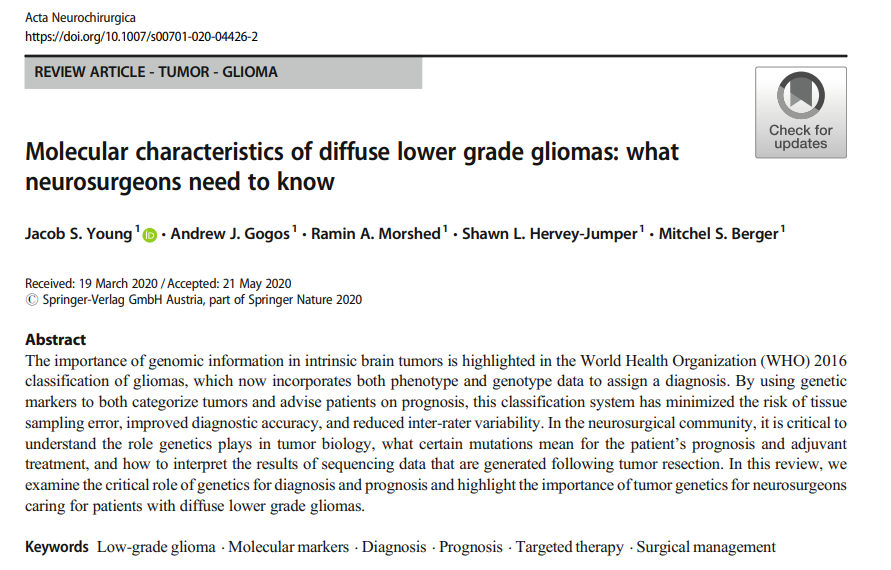Abstract
The importance of genomic information in intrinsic brain tumors is highlighted in the World Health Organization (WHO) 2016 classification of gliomas, which now incorporates both phenotype and genotype data to assign a diagnosis. By using genetic markers to both categorize tumors and advise patients on prognosis, this classification system has minimized the risk of tissue sampling error, improved diagnostic accuracy, and reduced inter-rater variability. In the neurosurgical community, it is critical to understand the role genetics plays in tumor biology, what certain mutations mean for the patient's prognosis and adjuvant treatment, and how to interpret the results of sequencing data that are generated following tumor resection. In this review, we examine the critical role of genetics for diagnosis and prognosis and highlight the importance of tumor genetics for neurosurgeons caring for patients with diffuse lower grade gliomas.
Introduction
Genomics has revolutionized how many solid malignancies are classified and treated. Not surprisingly, the introduction of next-generation sequencing has transformed the classification of low-grade gliomas (LGGs) and high-grade gliomas from a histological definition to a molecular one (for a list of landmark papers see Table 1). This revolution is highlighted in the World Health Organization (WHO) 2016 classification of gliomas, which incorporated both phenotype and genotype data to assign a diagnosis. In addition to clarifying diagnoses, a tumor’s molecular profile can aid in prognostication, identify potentially targetable mutations, and select for appropriate clinical trial enrollment. As a result, in addition to understanding how a tumor’s size, location, and performance status influence a patient’s outcome, it is now necessary for surgeons to understand the mutational profile of a diffuse lower grade glioma, as the tumor’s individual mutation profile is critical for appropriate prognostication and patient education. In this comprehensive, non-systematic review, we discuss these relevant molecular markers for low and lower (i.e., grade II or III) grade gliomas.
Conclusion
There is no doubt molecular characterization of diffuse LGGs has improved the diagnostic accuracy and prognostication of patients. As neurosurgeons, an understanding of the clinical course for a patient based on these molecular traits of the tumor is crucial for managing recurrences and understanding the adjuvant therapies that may be available for a particular patient. In the future, it is possible that imaging features of the tumor may be able to differentiate the tumor mutational profile and help clarify if there is true progression versus pseudoprogression, and it will be important for surgeons to take this information into consideration during operative planning. Ongoing research is investigating the potential for targeted agents against certain mutations and it remains to be seen if these may eventually play a role in patient care.

摘要:国际卫生组织(WHO)2016年胶质瘤分类强调了基因信息在内在脑肿瘤中的重要性,该分类现在结合了表型和基因型数据来指定诊断。通过使用遗传标记物对肿瘤进行分类并为患者提供预后建议,该分类系统将组织取样错误的风险降至较低,提高了诊断准确性,并减少了评分者之间的差异性。基因突变对肿瘤的预后有何影响,了解基因突变对肿瘤预后的影响。在这篇综述中,我们检查遗传学对诊断和预后的关键作用,并强调肿瘤遗传学对于神经外科医生治疗弥漫性低级别胶质瘤的重要性。
介绍:基因组学完全改变了许多实体恶性肿瘤的分类和治疗方式。新一代测序的引入已经将低级别胶质瘤(LGGs)和高级胶质瘤的分类从组织学定义转变为分子定义。这场革命在国际卫生组织(WHO)2016年胶质瘤分类中得到了强调,该分类结合了表型和基因型数据来指定诊断。除了明确诊断,肿瘤的分子特征还可以帮助评估,识别潜在的靶向突变,并选择合适的临床试验登记。因此,除了了解肿瘤的大小、位置和性能状态如何影响患者的预后外,现在外科医生还需要了解弥漫性低级别胶质瘤的突变情况,因为肿瘤的个体突变特征对于适当的评估和患者的了解至关重要。在这篇多方位的、非系统性的综述中,我们讨论了低级别和低级别(即二级或三级)胶质瘤的相关分子标记。

结论:毫无疑问,弥漫性LGGs的分子鉴定提高了诊断的准确性和患者的预后。作为神经外科医生,基于肿瘤的这些分子特征来理解患者的临床过程对于管理复发和理解可能对特定患者可用的辅助疗法至关重要。在未来,肿瘤的影像学特征可能能够区分肿瘤的突变情况,并有助于澄清是否存在真进展与假进展,这对外科医生在手术计划中考虑这些信息是很重要的。正在进行的研究正在调查针对某些突变的靶向药物的潜力,这些药物是否较终在患者护理中发挥作用仍有待观察。
关于美国Mitchel Berger教授

美国神经外科学会主席(2015年)
美国神经学医师协会主席(2012年)
美国神经学医师协会副主席(2010年)
加州大学旧金山分校医学中心(UCSF)神经科教授及主席
加州大学旧金山分校医学中心(UCSF)神经外科研究中心及脑肿瘤中心主任
加州大学旧金山分校医学中心(UCSF)Helen Diller家庭综合癌症中心名誉教授
美国国家“癌症登月”计划蓝带小组专家
美国Castle Connolly “America’s Top Doctors for Cancer”(2004)
美国神经学医师协会董事会(2007-2010年)
美国神经肿瘤学会主席(1997-1999年)
美国Mitchel Berger教授是全美公认的治疗成人和儿童的脑和脊髓肿瘤方面的专家,在脑部术中建图方面拥有丰富的知识,能够准确识别运动、感觉和语言功能的部位,从而避免在手术过程中伤及重要神经。Mitchel Berger教授是一位多产的作者,他为同行评审的期刊撰写了500多篇科学论文,编写了6本教科书,其中以《神经肿瘤学要点》教科书比较有名。此外,他还撰写了80多篇关于各种神经外科主题的章节。他目前是几家前沿期刊的编辑委员会成员,包括Neuro-Oncology和Neurosurgery。
原文链接:https://www.sci-hub.pl/10.1007/s00701-020-04426-2




